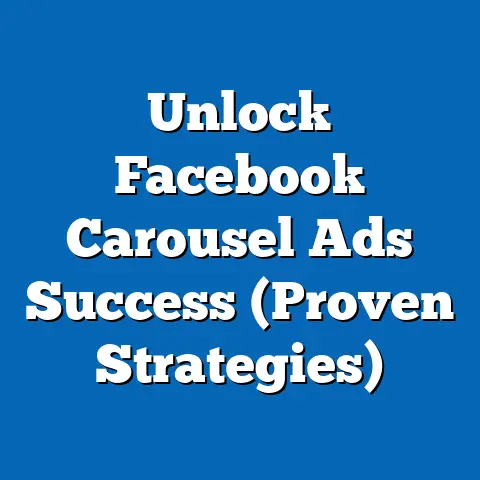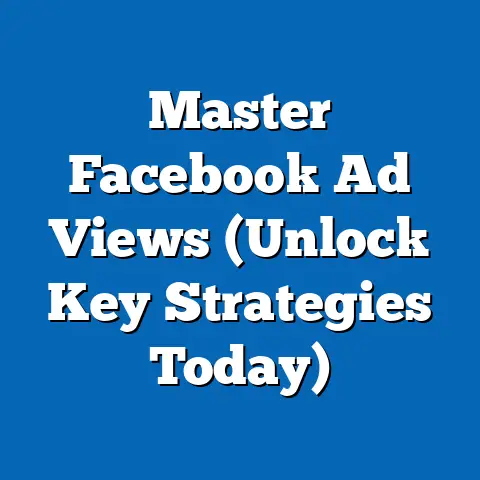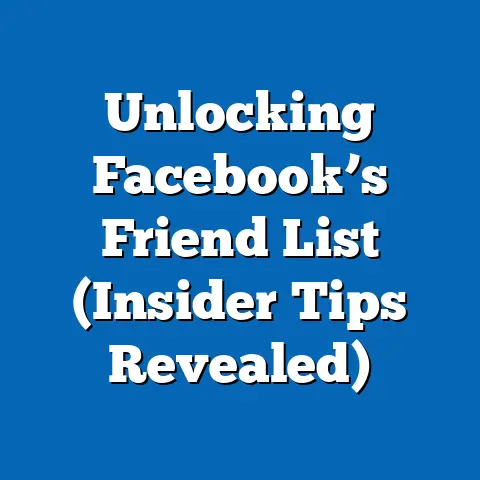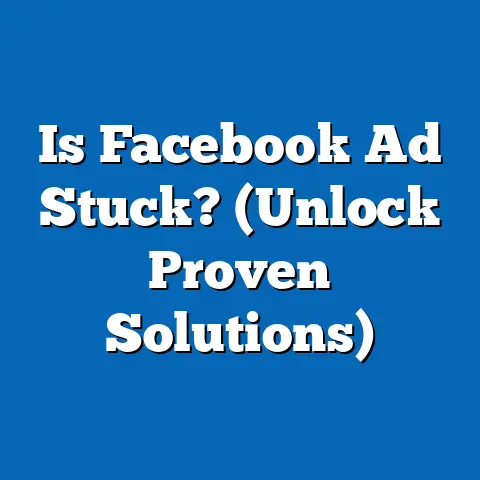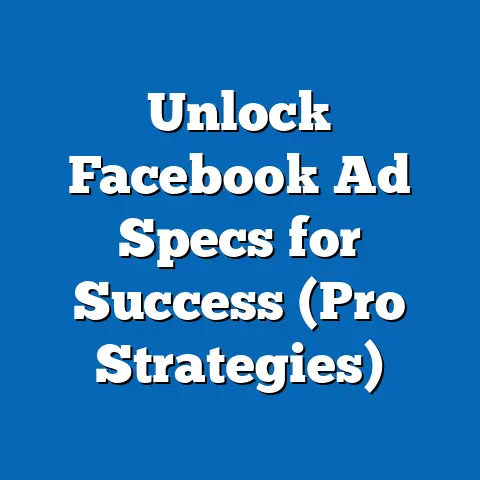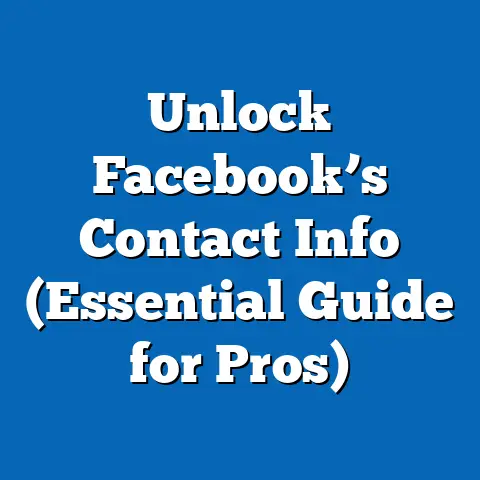Create Instagram Ads via Facebook (Master the Strategy)
Have you ever imagined how your brand could skyrocket in visibility and sales by tapping into the world of Instagram ads through Facebook’s powerful advertising platform? I know I did, years ago when I first started experimenting with social media advertising. Back then, the possibilities felt endless, and honestly, they still do! In this guide, I’m going to walk you through everything you need to know to create effective Instagram ads using Facebook Ads Manager, from setting up your account to analyzing your results and optimizing for maximum ROI. Let’s dive in and turn those aspirations into reality!
Understanding the Instagram and Facebook Ecosystem
Before we jump into the nitty-gritty of creating ads, it’s crucial to understand the relationship between Instagram and Facebook and how this connection benefits advertisers like you and me.
The Connection Between Instagram and Facebook
Facebook acquired Instagram in 2012, and this acquisition has created a seamless advertising experience for marketers. The key benefit here is the centralized ad management. Instead of managing separate campaigns on two distinct platforms, you can control your Instagram ads directly from the Facebook Ads Manager. This means you can leverage Facebook’s robust targeting options, detailed analytics, and sophisticated optimization algorithms for your Instagram campaigns.
I remember when the integration was first rolled out, it was a game-changer. Suddenly, I could reach a whole new audience segment on Instagram using the same data and insights I was already gathering on Facebook. It streamlined my workflow and allowed me to focus more on creative strategy and less on platform management.
User Demographics and Behavior
Instagram is a visual platform, heavily favored by younger demographics. According to recent statistics, a significant portion of Instagram users are between the ages of 18 and 34. What does this mean for you? It means if your target audience falls within this age range, Instagram is a goldmine.
Beyond age, understanding user behavior is equally important. Instagram users are highly engaged, often browsing the platform multiple times a day. They’re receptive to visually appealing content and are more likely to interact with brands that tell compelling stories.
For instance, I once ran a campaign for a local coffee shop targeting Instagram users within a 5-mile radius. The ads featured beautifully styled photos of their signature lattes and engaging captions about the shop’s cozy atmosphere. The campaign was a huge success because it resonated with the platform’s visual nature and the audience’s desire for unique experiences.
Benefits of Advertising on Instagram
Why choose Instagram over other advertising platforms? Here are a few key benefits:
- Visual Appeal: Instagram is all about visuals. If you have stunning images or videos, your ads are more likely to stand out and grab attention.
- High Engagement Rates: Instagram users are highly engaged, meaning they’re more likely to like, comment, share, and save your ads.
- Brand Storytelling: Instagram is a fantastic platform for telling your brand’s story through visuals and compelling captions.
- Precise Targeting: Thanks to Facebook’s data, you can target your ads to incredibly specific audiences based on demographics, interests, behaviors, and more.
- Seamless Integration: Managing your Instagram ads through Facebook Ads Manager simplifies the process and allows you to leverage Facebook’s powerful tools.
Takeaway: Understanding the connection between Instagram and Facebook, the demographics of Instagram users, and the benefits of advertising on the platform is the foundation for a successful Instagram ad strategy.
Setting Up Your Facebook Ads Manager for Instagram
Now that we’ve covered the basics, let’s get practical. Here’s how to set up your Facebook Ads Manager for Instagram advertising.
Creating a Facebook Ads Manager Account
If you don’t already have a Facebook Ads Manager account, here’s how to create one:
- Go to Facebook Business Manager: Visit business.facebook.com and click “Create Account.”
- Follow the Prompts: Enter your business name, your name, and your business email address.
- Fill Out Business Details: Provide details about your business, such as address, phone number, and website.
- Create an Ad Account: Once your Business Manager account is set up, you’ll need to create an ad account. Go to “Ad Accounts” in the Business Settings and click “Add.” Choose “Create a new ad account” and follow the prompts.
Creating an ad account might seem daunting at first, but it’s a crucial step. I remember helping a local bakery set up their ad account, and they were initially overwhelmed. But once they had it set up, they were able to start running targeted ads that significantly increased their foot traffic.
Linking Your Instagram Account
To run ads on Instagram, you need to connect your Instagram business account to your Facebook Ads Manager. Here’s how:
- Go to Business Settings: In your Facebook Business Manager, click on “Business Settings.”
- Select Instagram Accounts: In the left-hand menu, click on “Instagram Accounts.”
- Add Your Account: Click the “Add” button.
- Connect or Claim: You can either connect an existing Instagram business account or claim an Instagram account that already exists. Follow the prompts to complete the process.
Make sure your Instagram account is set up as a business account. This is essential for running ads and accessing valuable analytics.
Navigating the Ads Manager Interface
The Facebook Ads Manager interface can be a bit overwhelming at first, but once you understand the key features, it becomes much easier to navigate. Here’s a quick overview:
- Campaigns: This is where you set your overall advertising objective (e.g., awareness, traffic, engagement).
- Ad Sets: This is where you define your target audience, budget, and schedule.
- Ads: This is where you create the actual ads that will be displayed on Instagram.
- Reporting: This is where you analyze your ad performance and track your results.
I always recommend spending some time exploring the Ads Manager interface before launching your first campaign. Click around, familiarize yourself with the different options, and don’t be afraid to experiment.
Takeaway: Setting up your Facebook Ads Manager and linking your Instagram account are essential steps for running ads on Instagram. Take the time to familiarize yourself with the Ads Manager interface to make the process smoother.
Crafting Your Instagram Ad Strategy
Now that you have your accounts set up, let’s talk strategy. A well-defined strategy is crucial for achieving your advertising goals on Instagram.
Defining Your Goals
What do you want to achieve with your Instagram ads? Are you looking to:
- Increase Brand Awareness?
- Drive Traffic to Your Website?
- Generate Leads?
- Increase Sales?
- Promote an Event?
Your advertising objective will influence your targeting, ad format, and budget. For example, if you’re looking to increase brand awareness, you might focus on reaching a broad audience with visually appealing ads. If you’re looking to generate leads, you might use a lead generation ad format and target a more specific audience.
I once worked with a clothing boutique that wanted to increase online sales. We set their advertising objective to “Conversions” and created ads that showcased their latest collection with a direct call-to-action to “Shop Now.” The campaign was highly successful because it aligned their advertising objective with their business goal.
Identifying Your Target Audience
Who are you trying to reach with your Instagram ads? Defining your target audience is crucial for ensuring your ads are seen by the right people. Here are a few factors to consider:
- Demographics: Age, gender, location, education, income.
- Interests: Hobbies, passions, activities.
- Behaviors: Online habits, purchase history, device usage.
Facebook Ads Manager offers a variety of targeting options, including:
- Custom Audiences: Target people who have already interacted with your business, such as website visitors, email subscribers, or customers.
- Lookalike Audiences: Target people who are similar to your existing customers.
- Interest-Based Targeting: Target people based on their interests and hobbies.
- Behavior-Based Targeting: Target people based on their online behavior and purchase history.
I always recommend starting with a broad audience and then refining your targeting based on your ad performance. A/B testing different audiences can help you identify the most responsive segments.
Choosing the Right Ad Format
Instagram offers a variety of ad formats, each with its own strengths and weaknesses:
- Photo Ads: Simple and visually appealing, photo ads are great for showcasing your products or services.
- Video Ads: Engaging and dynamic, video ads are perfect for telling your brand’s story.
- Carousel Ads: Allow users to swipe through multiple images or videos, making them ideal for showcasing a range of products or features.
- Stories Ads: Full-screen ads that appear between users’ stories, offering a highly immersive experience.
- Reels Ads: Short-form video ads that appear in the Reels tab, perfect for capturing attention and driving engagement.
The best ad format for your campaign will depend on your advertising objective and your target audience. For example, if you’re looking to drive traffic to your website, a photo ad with a clear call-to-action might be the best choice. If you’re looking to increase brand awareness, a video ad that tells your brand’s story might be more effective.
Takeaway: Crafting a solid Instagram ad strategy involves defining your goals, identifying your target audience, and choosing the right ad format. Take the time to plan your strategy carefully to maximize your results.
Designing Compelling Instagram Ads
Now that you have your strategy in place, it’s time to create some eye-catching ads that will grab attention and drive results.
Visual Elements That Captivate
On Instagram, visuals are everything. Your ads need to be visually stunning to stand out from the crowd. Here are a few tips:
- Use High-Quality Images and Videos: Avoid blurry or pixelated images. Invest in professional photography or videography if possible.
- Maintain Consistent Branding: Use your brand colors, fonts, and logo in your ads to create a cohesive look and feel.
- Use Color Psychology: Choose colors that evoke the emotions you want to convey. For example, blue is often associated with trust and reliability, while red is associated with excitement and passion.
- Showcase Your Products or Services in Action: Don’t just show a static image of your product. Show it being used in a real-life scenario.
I’ve seen firsthand how much of a difference high-quality visuals can make. I once worked with a restaurant that was running ads with poorly lit, unappetizing photos of their food. We invested in professional food photography, and the results were immediate. Their click-through rates and conversion rates skyrocketed.
Crafting Engaging Copy
While visuals are important, your ad copy is equally crucial. Your copy should be concise, engaging, and relevant to your target audience. Here are a few tips:
- Start with a Hook: Grab attention with a compelling headline or opening sentence.
- Highlight the Benefits: Focus on the benefits of your product or service, rather than just the features.
- Use a Clear Call-to-Action (CTA): Tell people what you want them to do, whether it’s “Shop Now,” “Learn More,” or “Sign Up.”
- Keep it Short and Sweet: Instagram users are scrolling quickly, so your copy needs to be easy to read and understand.
I’ve found that using questions in your ad copy can be a great way to engage your audience. For example, “Are you tired of feeling tired?” or “Looking for the perfect gift?”
Utilizing User-Generated Content
User-generated content (UGC) is content created by your customers. It can be a powerful tool for building trust and authenticity in your ads. Here are a few ways to use UGC in your Instagram ads:
- Feature Customer Photos or Videos: Ask your customers to share photos or videos of themselves using your products or services.
- Run a Contest or Giveaway: Encourage customers to create content for a chance to win a prize.
- Ask for Testimonials: Feature customer testimonials in your ads.
UGC is incredibly effective because it’s authentic and relatable. People are more likely to trust recommendations from other customers than they are from brands themselves.
Takeaway: Designing compelling Instagram ads involves creating visually stunning images or videos, crafting engaging copy, and utilizing user-generated content. Put yourself in your target audience’s shoes and ask yourself, “Would I click on this ad?”
Budgeting and Bidding Strategies
Now that you know how to create great ads, let’s talk about budgeting and bidding. This is where things can get a bit technical, but understanding these concepts is essential for maximizing your ROI.
Understanding Ad Costs on Instagram
Instagram ad costs are determined by a variety of factors, including:
- Target Audience: The more specific your target audience, the higher your ad costs will be.
- Ad Placement: Different ad placements have different costs. For example, ads in Stories tend to be cheaper than ads in the main feed.
- Ad Relevance: The more relevant your ad is to your target audience, the lower your ad costs will be.
- Competition: The more advertisers targeting the same audience as you, the higher your ad costs will be.
- Bidding Strategy: Your bidding strategy can significantly impact your ad costs.
Two key metrics to understand are:
- CPC (Cost Per Click): The amount you pay each time someone clicks on your ad.
- CPM (Cost Per Mille): The amount you pay for every 1,000 impressions (times your ad is shown).
I always recommend monitoring your CPC and CPM to ensure you’re getting the best value for your money.
Setting Your Budget
How much should you spend on your Instagram ads? The answer depends on your advertising goals, your target audience, and your budget. Here are a few guidelines:
- Start Small: If you’re new to Instagram advertising, start with a small daily budget and gradually increase it as you see results.
- Set a Lifetime Budget: If you’re running a campaign for a specific period of time, set a lifetime budget to ensure you don’t overspend.
- Monitor Your Spending: Keep a close eye on your ad spending and adjust your budget as needed.
- Consider Your ROI: Make sure your ad spending is generating a positive return on investment.
I once worked with a startup that was on a tight budget. We started with a daily budget of just $5 and gradually increased it as we saw positive results. By carefully monitoring their spending and optimizing their ads, we were able to achieve a significant ROI.
Bidding Strategies
Facebook Ads Manager offers two main bidding strategies:
- Automatic Bidding: Facebook automatically sets your bids to get the most results for your budget.
- Manual Bidding: You set your own bids, giving you more control over your ad costs.
Automatic bidding is a good option for beginners, as it simplifies the process. However, manual bidding can be more effective if you have a good understanding of ad costs and your target audience.
I typically recommend starting with automatic bidding and then switching to manual bidding once you have enough data to make informed decisions.
Takeaway: Understanding ad costs, setting your budget, and choosing the right bidding strategy are crucial for maximizing your ROI on Instagram. Don’t be afraid to experiment and adjust your strategy as needed.
Launching Your Instagram Ad Campaign
You’ve done all the prep work, now it’s time to launch your Instagram ad campaign!
Final Checks Before Launch
Before you hit the “Publish” button, make sure to double-check the following:
- Targeting: Is your target audience correctly defined?
- Ad Creative: Are your images or videos high-quality and engaging?
- Ad Copy: Is your copy clear, concise, and relevant?
- Call-to-Action: Is your call-to-action clear and compelling?
- Budget: Is your budget set correctly?
- Placement: Are you targeting the correct Instagram placements (feed, stories, reels)?
- Ad Preview: Does your ad look good on both desktop and mobile devices?
I can’t stress enough the importance of these final checks. I once launched a campaign with a typo in the ad copy, and it cost me a significant amount of money before I caught the mistake.
Launching the Campaign
Once you’ve double-checked everything, it’s time to launch your campaign. Here’s how:
- Go to Facebook Ads Manager: Navigate to your Facebook Ads Manager account.
- Select Your Campaign: Choose the campaign you want to launch.
- Review Your Ad Sets and Ads: Make sure everything is set up correctly.
- Click “Publish”: Hit the “Publish” button to launch your campaign.
Congratulations, you’ve launched your Instagram ad campaign! Now it’s time to monitor your results and make adjustments as needed.
Takeaway: Before launching your Instagram ad campaign, make sure to double-check all your settings and ad creative. Once you’re confident that everything is set up correctly, hit the “Publish” button and start driving results!
Analyzing Ad Performance
Launching your campaign is just the beginning. To truly master Instagram advertising, you need to analyze your ad performance and make data-driven decisions.
Key Metrics to Monitor
Here are some of the key metrics you should be monitoring:
- Impressions: The number of times your ad is shown.
- Reach: The number of unique people who saw your ad.
- Engagement: The number of likes, comments, shares, and saves your ad received.
- Click-Through Rate (CTR): The percentage of people who clicked on your ad after seeing it.
- Conversion Rate: The percentage of people who completed a desired action (e.g., making a purchase, signing up for a newsletter) after clicking on your ad.
- Cost Per Click (CPC): The amount you paid for each click on your ad.
- Cost Per Conversion: The amount you paid for each conversion.
- Return on Ad Spend (ROAS): The amount of revenue you generated for every dollar you spent on ads.
I always recommend creating a spreadsheet to track these metrics over time. This will help you identify trends and make informed decisions about your ad strategy.
Using Facebook Analytics Tools
Facebook Ads Manager offers a variety of built-in analytics tools that you can use to track and analyze your ad performance. Here are a few key features:
- Reporting Dashboard: Provides an overview of your key metrics, such as impressions, reach, engagement, and conversion rates.
- Customizable Reports: Allows you to create custom reports that focus on the metrics that are most important to you.
- Breakdown Analysis: Allows you to break down your data by demographics, placement, and other factors.
- Attribution Modeling: Helps you understand how different ads and touchpoints contribute to your overall results.
I encourage you to explore these tools and experiment with different reports and analyses. The more you understand your data, the better you’ll be able to optimize your ads.
Making Data-Driven Decisions
The ultimate goal of analyzing your ad performance is to make data-driven decisions that improve your results. Here are a few examples:
- If your CTR is low: Try improving your ad creative or targeting a more relevant audience.
- If your conversion rate is low: Make sure your landing page is optimized for conversions and that your offer is compelling.
- If your CPC is high: Try experimenting with different bidding strategies or targeting a less competitive audience.
- If your ROAS is low: Re-evaluate your entire ad strategy and make adjustments as needed.
I’ve seen countless businesses transform their ad performance by simply paying attention to their data and making informed decisions.
Takeaway: Analyzing your ad performance is crucial for maximizing your ROI on Instagram. Monitor your key metrics, use Facebook’s analytics tools, and make data-driven decisions to improve your results.
Optimizing Your Instagram Ads
Now that you know how to analyze your ad performance, let’s talk about optimization. Optimizing your ads is an ongoing process that involves making small adjustments to improve your results.
A/B Testing
A/B testing is a powerful technique for comparing different versions of your ads to see which one performs better. Here are a few things you can A/B test:
- Ad Creative: Test different images or videos.
- Ad Copy: Test different headlines, descriptions, and calls-to-action.
- Targeting: Test different audiences.
- Placement: Test different Instagram placements (feed, stories, reels).
- Bidding Strategy: Test different bidding strategies.
I always recommend running A/B tests on a regular basis to identify what works best for your target audience.
Iterating Based on Performance
Once you’ve collected enough data from your A/B tests, it’s time to iterate on your ads. This involves making changes to your ads based on what you’ve learned. For example, if you found that a particular image performed better than another, you would use that image in your future ads.
I’ve found that small, incremental changes can often have a big impact on your ad performance.
Scaling Successful Campaigns
Once you’ve identified a campaign that’s performing well, it’s time to scale it up. This involves increasing your budget, expanding your audience, or both. However, it’s important to scale your campaigns gradually to avoid negatively impacting your results.
I typically recommend increasing your budget by no more than 20% at a time. This will allow you to monitor your results and make adjustments as needed.
Takeaway: Optimizing your Instagram ads is an ongoing process that involves A/B testing, iterating based on performance, and scaling successful campaigns. By continuously optimizing your ads, you can maximize your ROI and achieve your advertising goals.
Conclusion
So, have you started to envision how your brand could skyrocket in visibility and sales by tapping into the world of Instagram ads through Facebook’s powerful advertising platform? I hope so! We’ve covered a lot in this guide, from setting up your account to analyzing your results and optimizing for maximum ROI. Remember, mastering Facebook’s advertising tools to unlock the potential of Instagram ads takes time, patience, and a willingness to experiment. But with the right strategy and a commitment to continuous improvement, you can achieve incredible results. Now, go out there and start creating some amazing Instagram ads!

